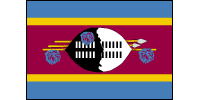| Country (long form) |
Kingdom of Swaziland |
| Capital |
Mbabane;
note - Lobamba is the royal and legislative capital |
| Total Area |
6,703.89 sq mi
17,363.00 sq km
(slightly smaller than New Jersey) |
| Population |
1,104,343 (July 2001 est.)
note: estimates for this country explicitly take into account the effects of excess mortality due to AIDS; this can result in lower life expectancy, higher infant mortality and death rates, lower population and growth rates, and changes in the distribution of population by age and sex than would otherwise be expected |
| Estimated Population in 2050 |
2,027,134 |
| Languages |
English (official, government business conducted in English), siSwati (official) |
| Literacy |
76.7% total, 78.0% male, 75.6% female (1995 est.) |
| Religions |
Protestant 55%, Muslim 10%, Roman Catholic 5%, indigenous beliefs 30% |
| Life Expectancy |
37.86 male, 39.4 female (2001 est.) |
| Government Type |
monarchy |
| Currency |
1 lilangeni (E) = 100 cents |
| GDP (per capita) |
$4,000 (2000 est.) |
| Industry |
mining (coal and asbestos), wood pulp, sugar, soft drink concentrates |
| Agriculture |
sugarcane, cotton, corn, tobacco, rice, citrus, pineapples, sorghum, peanuts; cattle, goats, sheep |
| Arable Land |
11% |
| Natural Resources |
asbestos, coal, clay, cassiterite, hydropower, forests, small gold and diamond deposits, quarry stone, and talc |
|


|